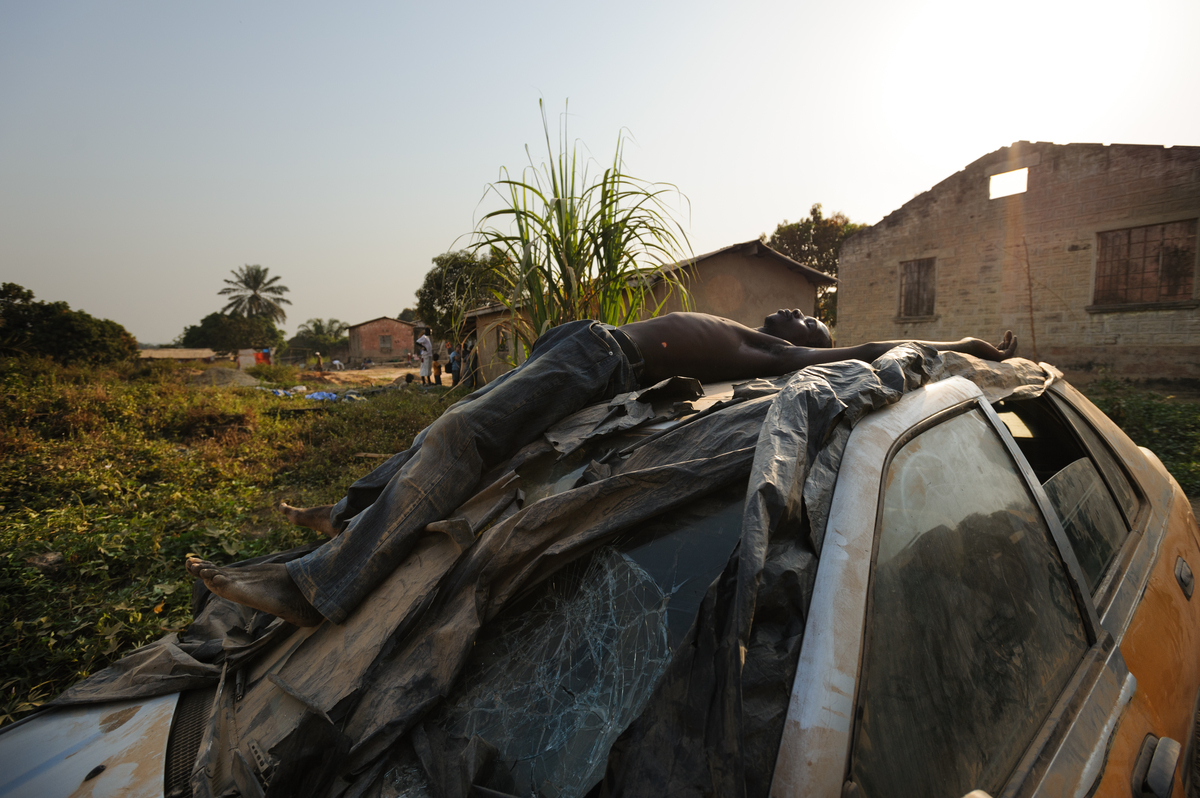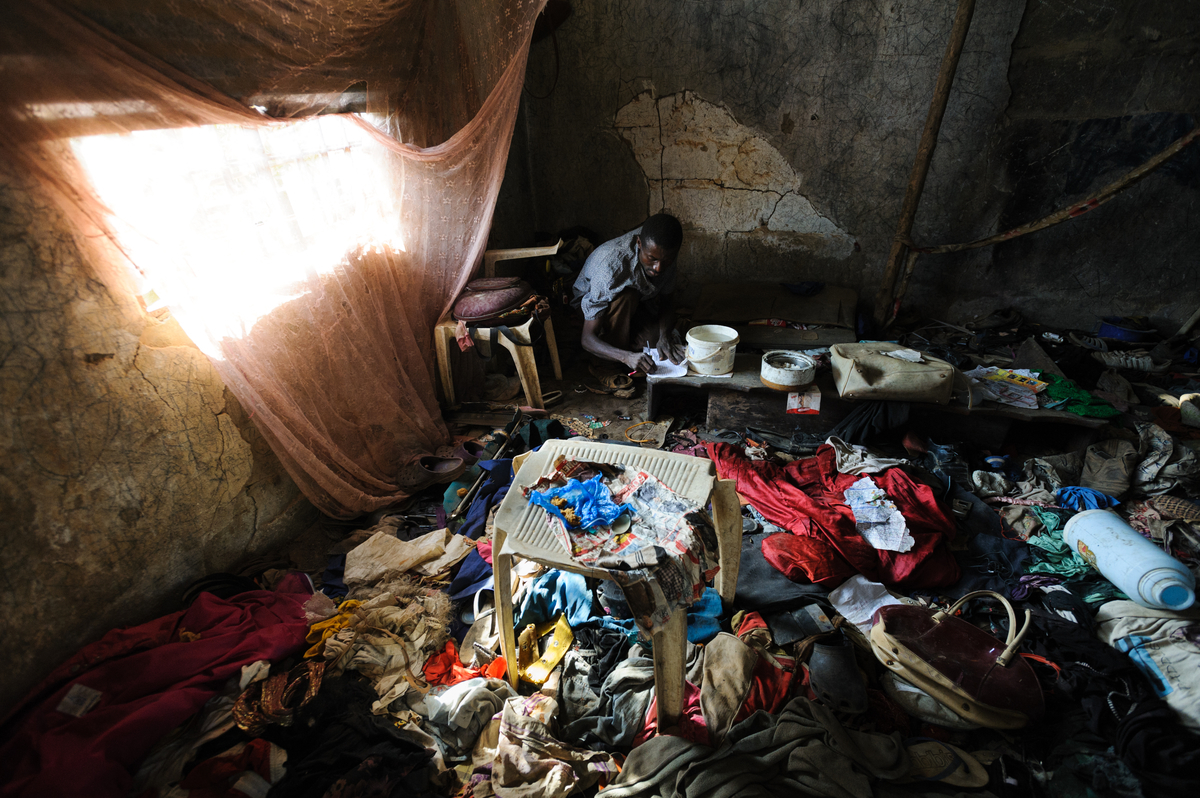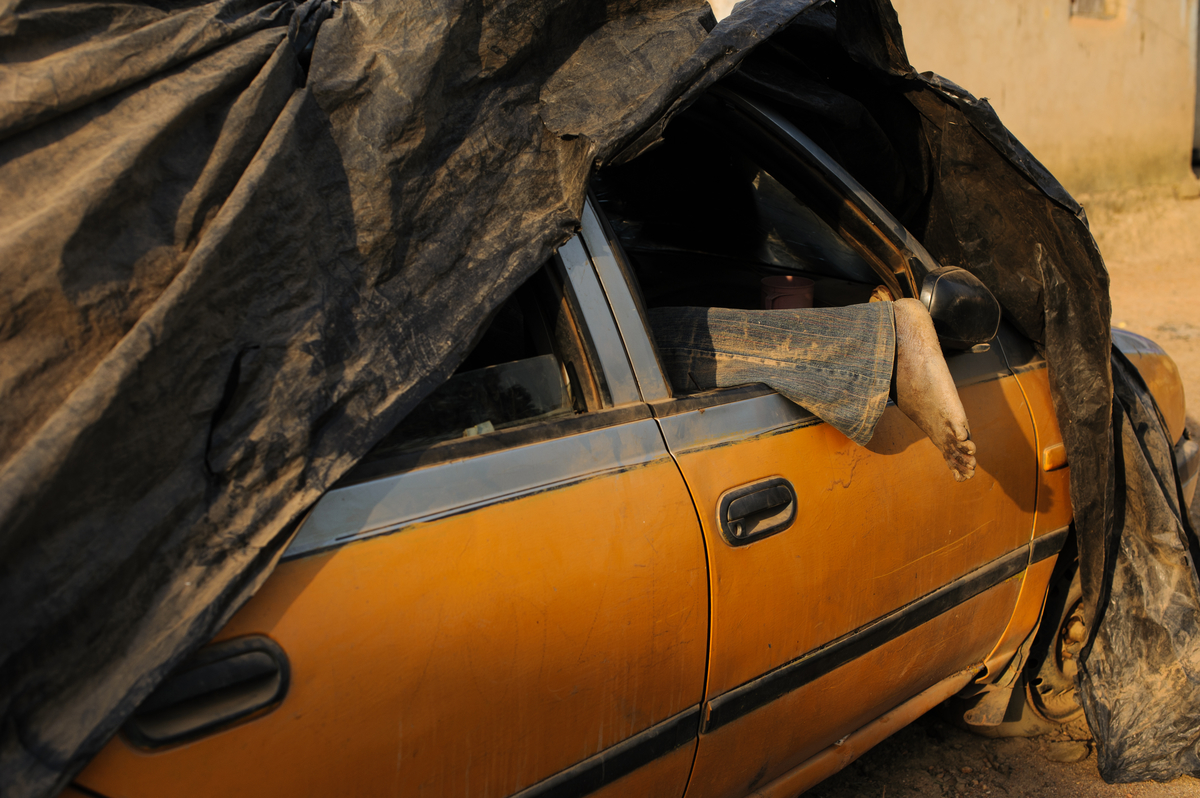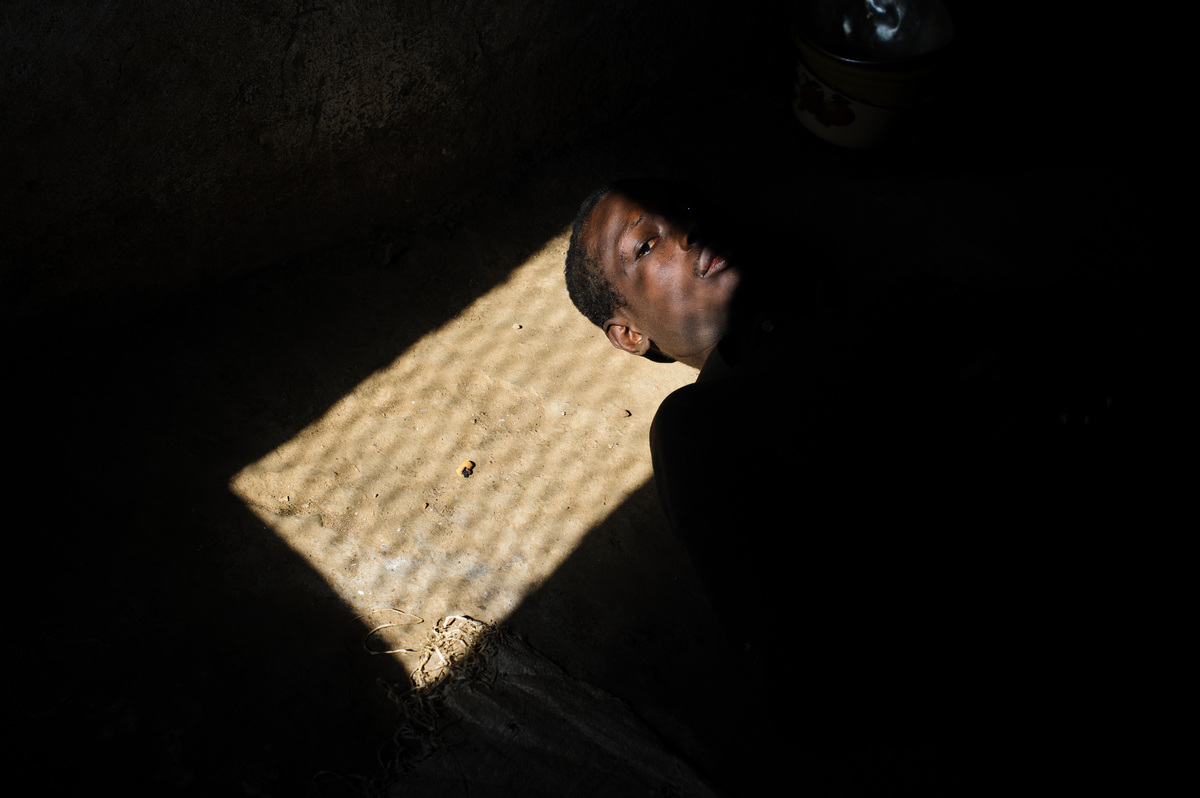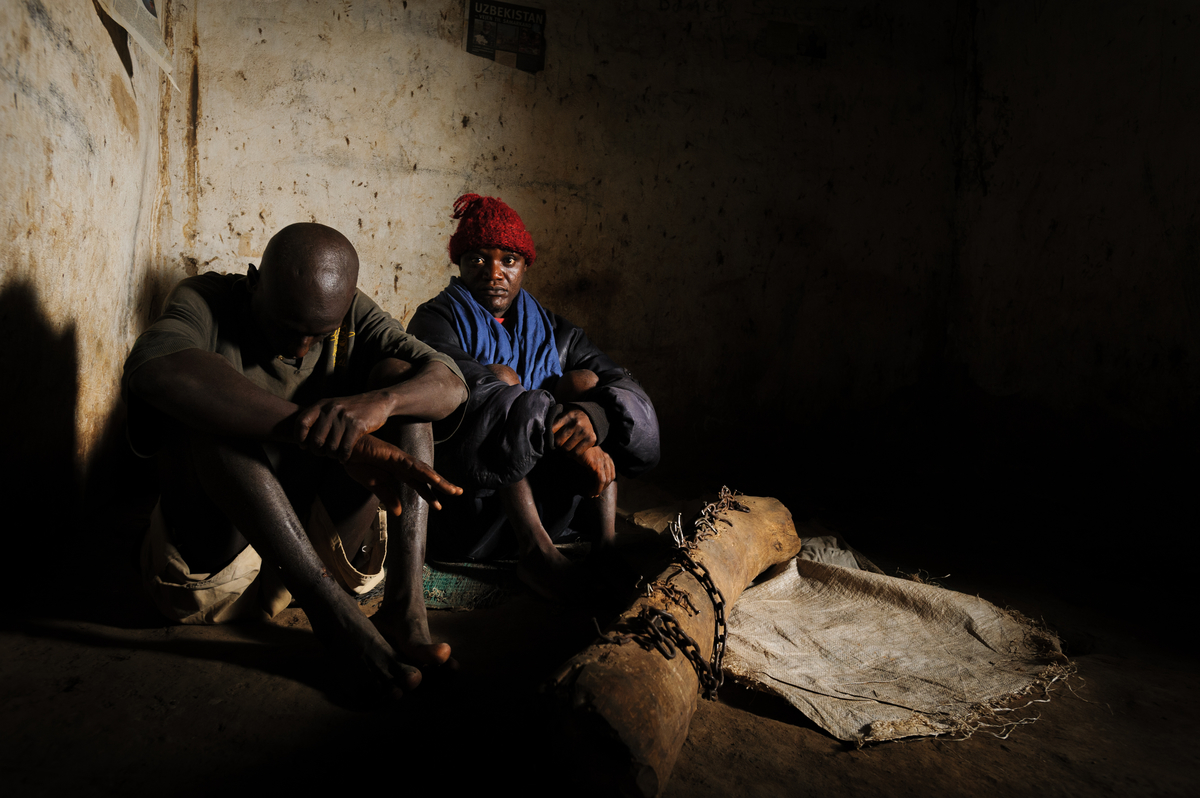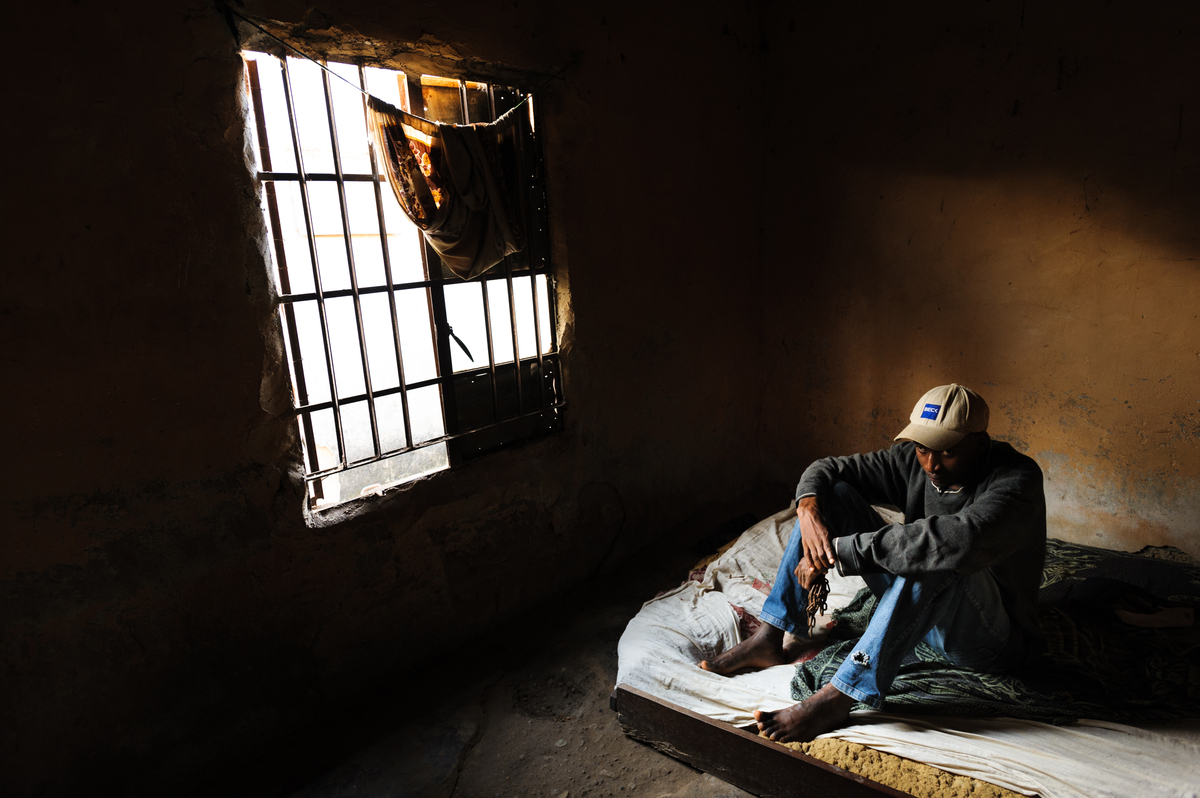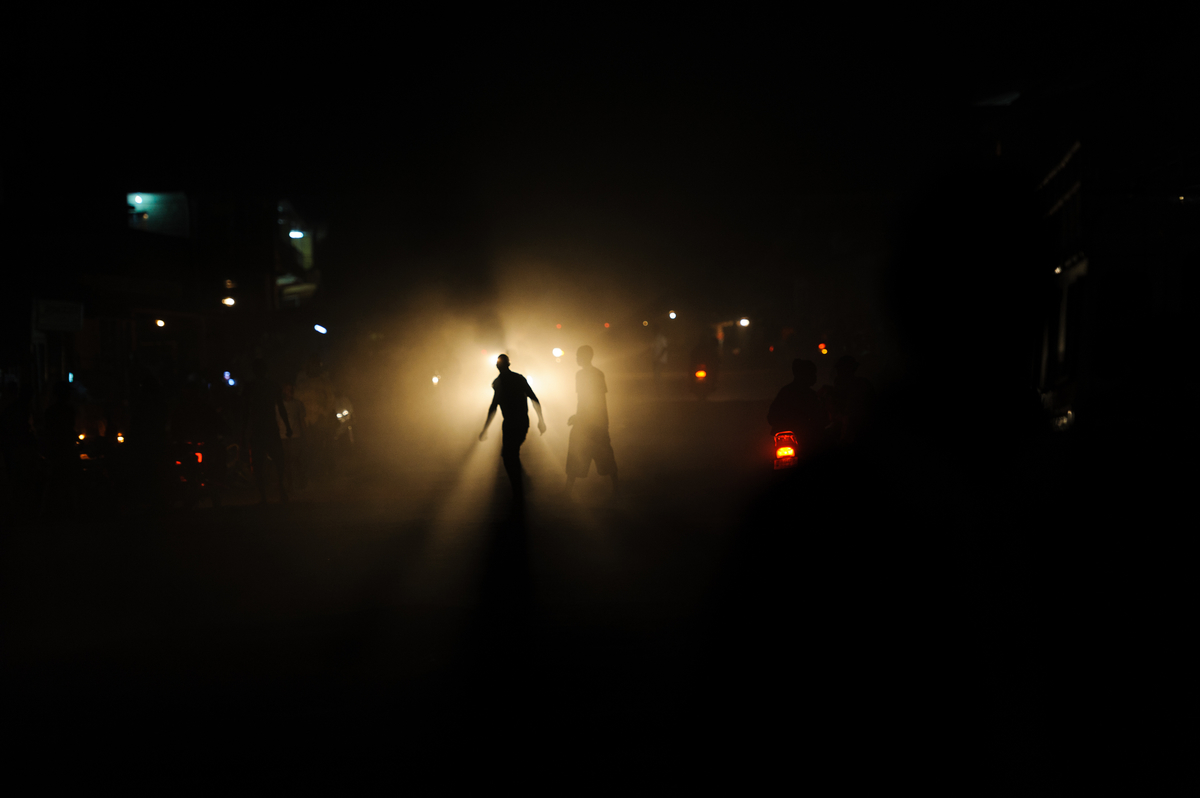A Wellbody patient, also named Mohammed, is one of those being treated through the mental health program. He had a tendency to wander, and family members say they used to have to restrain him with chain he is holding to prevent him from wandering - he once walked from his home near Koidu in eastern Sierra Leone to Makeni, a distance of some 160km. Though withdrawn and clearly still very unwell, since commencing treatment family members say he is calmer and no longer has to be restrained.
Photographer Nyani Quarmyne collaborated with writer Catherine Cooper.
Eight months ago, seventeen-year-old Fanta dreamt that a snake entered her mouth. She hasn’t spoken since. “Dr. Dan Kelly gave me mad medicine,” she writes in the notebook she uses to communicate. “But I rejected it. I said I am not mad. My issue is devils.”
It is the first Sunday of 2012, the annual Thanksgiving Celebration at Mount Moriah Church of Christ in Koidu, the capital of the Kono District in eastern Sierra Leone. Hundreds of people have come to drum and sing. After sharing a meal, they kneel before Reverend Aiah Nyamia Senesie to tell their stories of spiritual healing.
In a country with one psychiatrist, a chronically unreliable supply of medication, and overwhelming social stigma surrounding mental illness, most of those who receive psychiatric treatment spend their days chained to their beds at the “Craze Yard.”
“[I tried for] many years, but I got no child,” says a woman holding a sleeping baby in her arms. “My husband ignored me. Some said I was a witch. I prayed to God and he activated my womb. I have nothing, but I want to give thanks and praise to God.”
A man in a tan suit kneels in the dust and recounts how he had appendicitis but was too afraid to go to the government hospital for surgery. “I came to the Reverend, and he gave me an anointed word. After a week of using it, I got my healing,” he says. “I give praise to the almighty God.” He stands and places a handful of bills in a calabash on the Reverend’s table.
During the testimonies, Dr. Dan Kelly arrives. In 2006, Kelly, an American, and Sierra Leonean Dr. Bailor Barrie launched a mobile medical clinic that has become the Wellbody Alliance, a healthcare network with a clinical care facility, a team of community health workers, and several research and income-generating projects. In 2011, Wellbody launched the first mental health program in the district, one of only three in the country providing medication for those with mental, neurological, and substance use disorders. Because of a pervasive belief in Sierra Leone that mental illness is a spiritual disease, Dr. Barrie and Dr. Kelly decided to partner with a spiritual healer, Reverend Senesie, and a traditional healer (also known as a herbalist or witch doctor) named Alusine Kamara, offering both men financial incentives in return for reciprocal referrals.
After the testimonies, Dr. Kelly introduces me to Fanta. “This is one of our mental health patients,” he says, putting a hand on her shoulder. “She stopped talking after she dreamt the devil was having sex with her. I tried to start her on a low dose of antipsychotics, but she said she wanted to do spiritual healing instead.”
Kelly asks Fanta if Reverend Senesie’s interventions are helping. “I thank God,” she writes. “But the dream has not yet stopped.”
“Have you tried that witch doctor?”
“Yes, but he wants money.”
“Do you want to try the medicine again? It’s possible the medicine will pull out the snake.”
“Which kind of medicine?”
“Chlorpromazine.”
“Are you sure it can help me kill the devil?”
“Yeah, I think it can kill the devil.”
“I need it, sir.”
In a country with one psychiatrist, a chronically unreliable supply of medication, and overwhelming social stigma surrounding mental illness, the prospects for the mentally ill are bleak. Most of those who do receive psychiatric treatment spend their days chained to their beds at the only government-run mental health facility, known as the “Craze Yard.” The World Health Organization estimates that 75 percent of people with psychiatric disorders in the developing world have no access to medical care. The majority are hidden, abused, or abandoned, left to fend for themselves or work in return for treatment from traditional healers.
Though both are physicians—one specializing in pediatrics, the other in internal medicine—neither Barrie nor Kelly is a psychiatrist. In November 2011, Mandy Garber, a Sierra Leonean psychiatrist living in the United States, came to Kono for two days to diagnose patients. The plan was that Wellbody would treat and offer medication to the patients Garber had diagnosed, and continue diagnosing new patients, and the local Community Association for Psychosocial Support (CAPS) would provide free counseling and ensure that patients adhered to their drug regimens. In practice, the relationship has not been so straightforward. Many patients have neither fixed addresses nor family members to ensure they are taking their drugs, and if patients do take their drugs regularly, the supply of drugs is unreliable, so there is a risk of interruptions in treatment. But perhaps the biggest challenge of all is that patients simply do not have their basic needs met.
“What year is it, Moses?” Kelly asks.
Moses, who has been talking heatedly with someone he sees in the corner, looks up at his brother. “2003? Yes, it is 2003.” Isaiah tells us this was the year Moses became ill, the year after the war ended.
Recently, a patient named Moses was brought to Wellbody by his brother Isaiah. “When he came to the clinic, Moses was crying, ‘I’m hungry, I need food,’” says CAPS counselor Sahr Y. John. Because there was no food at the clinic, the two left. When John went to bring Moses back, Moses beat him with a belt and threw rocks at him. “I’m afraid to go back,” says John. “But his aggression is not all of the time. Nobody is giving him food, and that aggravates his anger.”
Moses lives above Isaiah’s house in a small room with a tin roof and door. When Moses becomes violent, his brother confines him there. When Kelly and I arrive, Moses is sitting on the floor of the room, which is carpeted with filthy clothing, broken toys, appliances and ants. Moses has covered the walls with scribbles made in white chalk.
“Every day he writes like this,” says Isaiah. “He goes around town, he does his writing very seriously, then when he gets hungry he becomes really wild. He fights himself. He acts as if he wants to eat another person.”
“What year is it, Moses?” Kelly asks.
Moses, who has been talking heatedly with someone he sees in the corner, looks up at his brother. “2003? Yes, it is 2003.” Isaiah tells us this was the year Moses became ill, the year after the war ended.
“Are you hearing voices, Moses?” Kelly asks.
“Yes.”
“What do they say?”
“They say I’m finished. Everything is finished with me.”
“He sees people we don’t see, and they are always attacking,” says Isaiah. “He will fight them until he is almost exhausted. I’m afraid that if care is not taken, one day he will harm someone.”
Kelly asks Isaiah if he would like to start Moses on medication. “He won’t take medicine if I haven’t fed him,” Isaiah says. “It may help him to function better, but it’s not food.” There is a loud explosion nearby from one of the many mining companies that operate in Kono, but Isaiah doesn’t seem to notice. “Each day I have to go and try to get food, and when I can’t he becomes so wild. Sometimes he just pulls his prick out. I say, ‘What’s your problem?’ He says, ‘I want to [eat],’ but I don’t have money. I tell him I’m trying. It’s a process.”
Like almost all of the patients Kelly has seen so far, Moses had already been through numerous spiritual interventions before coming to Wellbody. “We have been to jujumen, sorcerers,” Isaiah says. “People tell you try this, try this. I’ve tried everything, but now I’m out of money and the problem has not been solved.”
Kelly gives Isaiah two weeks’ worth of chlorpromazine and slips him some cash. As we are leaving, I ask Kelly if he knows what kinds of treatments are offered by the traditional healer Wellbody works with. “He and his crew make some concoctions to rub on people,” he says. “To be honest, I don’t know enough to really say. Whatever he does, he thinks he’s the best in the whole country. He’s got flair, I’ll give him that.”
Driving in Koidu is like taking one long short cut. There are rarely obvious delimitations between main thoroughfares, side streets, open spaces, and private properties, and—for someone unfamiliar with the place—there are very few landmarks to help you get your bearings. Dr. Barrie maneuvers confidently through what appear to be back yards, football fields, marketplaces, and alleys as we drive from the Wellbody Clinic to the traditional healer’s house.
When we arrive, we find Alusine Kamara sitting in the sunshine on a bench outside of his house, smoking a cigarette and smiling warmly. As he stands to greet us, he looks more like a cheerful grandfather than a man who deals with demons.
We sit with Kamara under a tree in the yard, and Barrie translates as he and Kamara speak in Kono, their tribal language. Kelly listens in, sometimes asking questions of his own.
Having practiced traditional medicine for forty years, Kamara says he can treat anything—substance abuse, epilepsy, schizophrenia, and “any ordinary demons.” First he prays until he has a vision of the demons that inhabit his patient, then he calls the demons to him and captures them. If necessary, he ties the patient up throughout this process.
Kamara explains that he has his own demons, who visit him two or three times a week and teach him how to capture demons in other people. Sometimes they show him which herbs to apply to the patient, sometimes they tell him to light a candle or sacrifice an animal.
I ask about the sores on Saffie’s body, and Finda tells me those are the places where the demons are coming out. “The child is under demon attack,” Kamara says. I ask why. “These are demons. They can do what they want,”
I ask Kamara which condition is the most difficult to treat, and without hesitating he says it is “special eyes,” which Dr. Barrie tells me is his term for schizophrenia. “Sometimes you ask them to do something, but the demons tell them not to, so you have to force them,” Kamara says. “But it’s not the patient you are fighting. It’s the demon.”
Kamara’s index fingers are both unnaturally short. One appears to have been cut off at the first joint, revealing exposed bone. The other is more or less complete, but withered and crooked. He tells us these were wounds inflicted by one of his patient’s demons when he lost consciousness while fighting them.
I ask to meet some some of Kamara’s patients, and he leads us toward a child sitting with her mother outside of his house. Saffie is eleven years old, but her gaunt face and eerily blank expression make her appear much older. Her hair has started to fall out, and the parts of her body that are exposed are startlingly thin and covered in sores.
Saffie’s mother, Finda, tells us that two weeks ago she went out to the market, and when she came back her daughter was lying rigid on the floor. She called Kamara and asked him to meet her at the government hospital, where Saffie was put on a drip and given medication. When Kamara arrived, he told Finda that Saffie was not “hospital sick,” so Saffie was discharged and brought here, where she has been drinking herbal concoctions and having herbs rubbed into her eyes. Finda says that before she came here, Saffie was in a coma, but now she is conscious, although she still can’t speak. “He has done well for us,” Finda says.
I ask about the sores on Saffie’s body, and Finda tells me those are the places where the demons are coming out. “The child is under demon attack,” Kamara says. I ask why. “These are demons. They can do what they want,” he says. He says that demons are just like humans. Some are good and some are bad, but his only want to do good. “My demons are like the soldiers, and the patient’s demons are like the rebels,” he says.
Kamara leads us to the end of a dark hallway and opens a padlocked door. Two men are lying on their backs on a concrete floor. I lean in to talk to the men, both of whom speak English, and the smell is overwhelming. They both came her voluntarily, they tell me, but Kamara had to lock them up so they wouldn’t leave. He has diagnosed one with special eyes and one with jamba, or substance-induced psychosis. I thank them, they both lie back down in the shadows, and Kamara closes and locks the door.
Kamara says he hopes his partnership with Wellbody will make him more popular, but it will benefit Wellbody more than it will benefit him, because he can treat many diseases that Western medicine can’t.
“The guy’s so full of himself,” says Barrie as we get in the car to leave. “He thinks we want to learn his practices and eventually steal the information from him.” I ask about Saffie, and both Barrie and Kelly agree that she probably has meningitis and may also have an underlying disease such as TB. Barrie attributes the improvement in her condition to the antibiotics she would have been given at the hospital, which she has presumably stopped taking.
“If they don’t give her the right treatment, she will probably die,” Kelly says. “Even if she survives, she will have permanent neurological damage.”
“Look at him,” Barrie says as he waves goodbye to Kamara. “He’s looking very proud.”
Back at the Wellbody Clinic a group of patients wait outside of the Mental Health Stabilization Centre, a sparse, one-room rectangular building covered with blue tarp. Kelly asks Barrie to sit in on his consultations, but Barrie refuses, and it quickly becomes clear that the two doctors have had this conversation before.
“You’re not a psychiatrist and neither am I,” Barrie says, “and some of these drugs can have lifelong effects.”
“The patients are getting better, man,” Kelly says. “You can follow them up and see. You can’t send them to the lab, but there are clear indications of illnesses. It’s like anything. You can misdiagnose anything.”
“It’s about your conscience,” Barrie replies. “When I feel like something isn’t my terrain but I do it because there is a need, that affects my conscience. It’s a tough decision to make, and I’ve been battling with that.”
“To ease your conscience,” Kelly says, “of the fifty or so patients that Mandy diagnosed, the majority are already on medication, so it’s mostly just refills. I don’t see how you can be uncomfortable with doing refills.”
“Even when you refill, you need to know if the dose should be changed,” Barrie counters. “I’m sorry, but I really don’t think this program is a priority. There are so many other things we should be focusing on.”
“We can’t shut down the program,” Kelly says. “The bottom line is that the benefits outweigh the risks.”
One of the people waiting to be seen by Dr. Kelly is Andrew. He has been brought to the clinic by his father, Davison, who says that his son worked as a forest ranger for the Ministry of Agriculture until four months ago. “I don’t know if it was done by witchcraft, but one day he just went out of his head,” Davison says. He took Andrew to Reverend Senesie’s church for prayers, and Reverend Senesie referred them to Wellbody for treatment.
When Kelly meets with them, Davison does the talking. “The medication is working,” he says. “Last time [Andrew] couldn’t even talk. Now he can talk for himself. He sleeps soundly when he takes the drugs. He also eats a lot.” When Kelly asks Andrew what the voices in his head say to him, Andrew takes a long time before answering, “It says, ‘Help me, help me. I’m not a devil.’”
After all of the patients have been seen, I ask Kelly what he thinks about the connection between mental health and the supernatural. “There are all these myths running around here about why things happen, because people aren’t grounded. With the spiritual healer and the traditional healer I guess it’s your heaven-versus-hell look at making someone better. Demons or God. And I’m somewhere in the middle. I feel grounded, and everyone else is just grasping at straws for whatever works.”
When I visit Reverend Senesie again, he is sleeping under a tree outside of his church, his Bible open on his lap. One of his parishioners insists on waking him. “This is my habit,” Senesie says. “When I’m not praying or evangelizing, I read the Bible. Anywhere sleep attacks me, that’s where I do it. People wake me if they need me.”
Every three hours, throughout the day and night, Senesie holds faith healing services for his parishioners. Many people come to several services in a twenty-four–hour period. Taking off their shoes and covering their heads before entering the walled area marked “Sacred Ground,” patients with all sorts of afflictions kneel to be prayed over and anointed by Senesie and his followers. “It’s tedious work,” he says. “You can’t do it with your own human strength. It’s God’s strength we are using.”
Like Kamara, Senesie has been in practice for forty years. He says that he received a message about his vocation during an extended fast. “On the twentieth day, I heard a voice speaking to me, telling me that he has given me the power to heal the sick and comfort the afflicted,” Senesie says. “I left my job and gave myself to the work of God.”
After he started a prayer ministry in his home, Senesie’s popularity grew quickly, and he continued to expand, building churches and training pastors for a growing ministry that he named the Mount Moriah Church of Christ. During the civil war, all of the buildings the Church had erected were destroyed, and Senesie was forced to flee to Guinea, but as soon as he came back he began the work of rebuilding. He now has a congregation of over 3,000 people and forty-two parishes across the country, each with a prayer ministry, an evangelical ministry, and various income-generating projects that sustain their work.
Senesie explains that as with Western medicine, the first step in spiritual healing is diagnosis. The patient and his or her family come to the spiritual healer, who prays and fasts, sometimes for as long as seven days, until the source of the patient’s sickness is revealed to him. “Some are demon-possessed, some have sicknesses in the body,” Senesie says. “But you know, this is a dark continent, and most of them are demon possessed.”
Once the source of the illness has been revealed, Senesie prays for insight into the best intervention for the patient. Some are anointed with blessed water, some are put in a circle of candles, some are told to fast. “All of that is working perfectly,” Senesie says.
Titus, six, has been living with Senesie for four months for treatment of his epilepsy. Before he came, he was having eight to ten fits a day, and Senesie says the fits caused him to become “mentally abnormal.” Since he has been treated through the prayer ministry, Senesie says Titus’ condition has improved significantly.
The boy’s illness began after his mother had an argument with an old woman, who told her, “You’ve insulted me, but I will deal with you. Tomorrow morning you will cry.” That night, Titus’s mother says she had a dream that the woman came and slapped her son, and the next morning Titus had his first fit. His mother took him to the traditional healer, who put herbs on him, but Senesie says that only made things worse.
According to Senesie, traditional healers are dangerous and exploitative because they give medicine without making proper diagnoses and demand large sums of money in return. He, on the other hand, uses only holy water and oil to heal people and doesn’t demand payment. “We do this for God’s sake,” he says. “If people want to give us something when they receive their healing, they can, but we don’t ask for it.”
Senesie says that traditional medicine is rarely effective, because almost all traditional healers work with demons. “There is no good demon on earth, no matter what they say,” he says. According to Senesie, when the traditional healer treats patients, he implants new demons in them as he removes others. He does this so the demon kingdom can grow, and because demons demand a regular supply of human blood. This is why traditional healers must make human sacrifices. “If a healer is strong, he’s not strong for nothing,” he says. “He’s providing human blood to feed his demons so he can continue in his strength.”
I ask Senesie what he thinks about the partnership Wellbody is seeking to create between himself, the clinic, and the traditional healer. He says that he has no desire to work with Kamara, and he wouldn’t encourage Wellbody to work with him either. However, if Wellbody identified a traditional healer who was not demon possessed, he would consider working with that person.
Senesie says that he suggested early on that in order to harness the power of the herbs the traditional healers use while avoiding the potential dangers involved in their practices, Wellbody could do workshops to teach traditional healers “to work in a modernized system.” Once Wellbody had identified a healer who was willing to work without demons, Senesie proposes, they could provide him with a space within their clinic, and he could be involved in treatment under the supervision of the clinic staff if the patient requested it.
“That’s the best way for them to do it,” Senesie says. “So everyone can see their own road clear.”
At a dark restaurant in the center of Koidu, Kelly draws a diagram of Wellbody’s programs on the back of a greasy placemat. The result looks how I would imagine a map of the district might appear to an outsider like me—a cluster of seemingly unrelated features with no clear categories or connections between them. Apart from the clinic and their community health work—which includes HIV, tuberculosis, antenatal care and amputee community programs—the doctors are engaged in a plethora of research and income-generating activities, including a palm oil farm and factory, microcredit services, and a goat rearing venture.
“We are really carrying the ball here,” says Kelly. “And when you’re in a situation where there’s so much need, it can be difficult to prioritize.”
Both Barrie and Kelly work punishing hours, starting most days at 7:00 a.m. and working until 2:00 or 3:00 the following morning doing administrative work, writing grant proposals, and compiling data for the clinic and various research projects. Kelly says the program is at its most complex point now, and ultimately they plan to merge the many components of Wellbody Alliance into an integrated model of healthcare that can be used elsewhere in Sierra Leone.
“Sierra Leone has taken over my life in a way,” says Kelly. “But I like Kono. Or I guess I like it, but I hate it. I’m a little masochistic at the end of the day.”
Nicknamed the “Wild East,” Kono does have the rough, single-minded feel of the mining towns in old Westerns. There are diamond dealers on every street, and bikers speed down the barren, dusty roads wearing surgical masks and winter parkas. Like the cowboys of that era, Kelly and Barrie’s life in this place might appear from a distance to be romantic and even heroic, but in reality it is characterized by hard work, bad food, isolation and, in the dry season, a proliferation of dust.
When they are in Koidu, which takes eight hours to reach from the capital on a notoriously terrible road, the doctors live in a spartan two-bedroom house near the clinic. The house is dark and musty, and it has no electricity or running water or any other attempt at comfort. There is nowhere to cook—most of Kelly and Barrie’s meals are bought on the street and eaten out of plastic bags.
“Some of the details aren’t wonderful, but there are some things in life that just need to get done,” Kelly says. “I grew up camping a lot, so it’s like an extended backpacking trip.” For Barrie, who has a wife and three young children in Freetown, the lifestyle is more challenging, but he doesn’t complain. “Honestly, I’m used to it,” he says. “There are times when I really miss my family, but I try to keep my mind off it, and when I’m in Freetown I try to spend a lot of time alone with them.”
“We’re doing this work that people think is glamorous, and it’s not glamorous at all,” Kelly says. “But the people we are serving are the poorest of the poor, and they are wonderful people, so I can’t lose my optimism because then I would start to hate the work I’m doing out here, and I can’t let that happen.”
When he first came to Sierra Leone on a global health fellowship, Kelly was still a student at the Albert Einstein School of Medicine. “It was both motivational and debilitating that first time,” he says. “I wanted to get involved, but at the same time I felt that the need was so overwhelming I didn’t know where to start. That’s why Bailor was such an important mentor for me at the beginning.”
“My first impression of Dan was that he was a real New Yorker—like, ‘Yeah man,’ a crazy guy,” says Barrie. “He looked like someone here to do an internship, but not someone passionate about poverty.” The two, who met through a mutual friend, visited several of the camps that had been set up after the war for amputees whose injuries were a hallmark of the conflict. Having witnessed firsthand the need among that population for reliable, quality healthcare, the two started discussing their mutual desire to serve the amputees, and Barrie suggested that they start an organization.
Two months after their first meeting, the young doctors had registered their NGO, and one month later Kelly left the country. “At that point I was honestly still skeptical about what he was really up to,” says Barrie. “I know there are a lot of white people coming to take pictures and write stories about the amputees. They make money but never come back.”
The pair conducted a needs assessment and decided to open a mobile clinic for amputees in Kono, but Barrie was still unsure of Kelly’s motives. “I was thinking why should we come to Kono? It’s a diamond-rich district. I was still watching him, making sure that he’s not doing something that I didn’t want to get into.”
It wasn’t until they broke ground for the permanent clinic that Barrie put his doubts to rest. “After that I was fully committed,” he says. “I was passionate about serving the poor long before Dan came along. Once I realized what he was doing was real, I gave all my life to this.”
Born in the village of Kamaquie, Mohammed Bailor Barrie grew up in family that, like most in Sierra Leone, lived on less than a dollar a day. His first job was selling kerosene, cigarettes, and roast meat on the side of the road to supplement his parents’ income, but he dreamt of one day becoming a doctor. His neighbor was a nurse who saw patients at home, and as a schoolboy Barrie used to pick up used syringes from the man’s garbage and use them to play doctor with his friends’ dolls. As he got older and realized that it would be practically impossible for him to attend university outside of the country, Barrie began to lose sight of his dream. Then, when he was in high school, Sierra Leone’s first medical school opened in Freetown. That gave him some hope, but he still knew that his family could never afford the tuition.
When Barrie was a teenager, his father left to mine for gold in the east. “He would come home to visit, and he would say, ‘Don’t worry, I’m working hard for you guys, things are going to change,’” Barrie remembers. After one year, Barrie’s father finally had enough saved up to come home and start the new life he had promised them. But the night before he left the town where he had been mining, someone stole his gold.
After that, Barrie says, his father’s mental health deteriorated. The family sent him to a traditional healer, and when Barrie visited him there, his father didn’t recognize him. “I would stand in front of him and say, ‘Daddy, it’s me,’ and he would bring out these pictures from magazines and show them to me and say, ‘These are my children. I love them. I’m working hard for them.’” After two years living with the traditional healer, Barrie’s father died.
When he had finished his first high school exams, Barrie learned that there was a new scholarship being offered to the two Sierra Leonean students who got the highest marks on their final exams. He was determined to win one of those scholarships, and he did—which enabled him to attend medical school. Barrie’s struggles didn’t end there, however. His scholarship only paid for his tuition, not his living expenses. “Medical school was a nightmare,” he says. He walked seven miles to and from school every day and copied his classmates textbooks by hand because he couldn’t afford to make photocopies. “At some point I wanted to quit because of the extreme suffering,” he says. “But I had the scholarship, so I held on. I was very thin at that time.”
In 1997, the rebels came to Freetown, the medical school closed down and Barrie fled to a refugee camp in Guinea, where he was enrolled in a program to immigrate to Canada. But when he heard that his school had reopened, he chose to go back to Freetown, realizing that if he went to Canada he might never be able to finish his medical degree. “It was risky,” he says, “but I’m really happy with the decision I made.”
As a Sierra Leonean practicing Western medicine in an area where people predominantly put their faith in traditional healers, Barrie walks a fine line between respecting his patients’ beliefs and trying to curb the use of what he calls “dangerous traditional practices.” Rather than condemning their methods, Barrie tells the traditional birth attendants Wellbody works with that he knows witches and demons exist—even though he doesn’t believe they do—in order to earn their trust so he can convince them to cease or alter the practices he considers to be most dangerous.
Barrie suggests that Wellbody should earn Kamara’s trust in a similar way so that he will change or replace his dangerous practices while continuing with the harmless ones. However, Barrie says, this should not be the first step in developing the mental health program, if they are going to develop it at all. The ideal strategy, Barrie says, would be to begin with a comprehensive, widespread mental health sensitization program. The next step Barrie proposes would be to analyze the herbs that the traditional healers are using and see what harmful and beneficial components they contain. He tells me about a hospital in India with a traditional medicine department, where traditional cures are purified and researched in labs. “You could do that here,” Barrie says, “But you can’t do it in a month or even a year. It takes time. We’re five months into this program now, and the country doesn’t even have a well-organized mental health program for us to link with.”
Barrie says he understands Kelly’s sense of urgency when so many lives are being lost to treatable illnesses. He also acknowledges that in the beginning it made sense to try to partner with the traditional healer. Initially, Barrie says, he and Kelly simply wanted to get as many patients as they could, and they didn’t care what happened as long as they were saving lives. It wasn’t until they started trying to work with the traditional healer that they realized that they were involved in a very complex situation. Now, Barrie says, the more he learns about Kamara, the less he wants to work with him. He even suggests that Kamara has schizophrenia himself, and that by working with him Wellbody is giving him credibility, which is very dangerous.
Barrie brings up Saffie, the little girl we saw at the traditional healer’s house. If Kamara agrees to let her come to the clinic, that might save her life, but the family will give Kamara credit for her recovery. If she comes to the clinic and doesn’t get better because the damage is already done, Barrie will be blamed. “I still want to save her life, though,” he says. “Maybe by going through the mother.”
Later that day, Barrie and I return to the traditional healer’s house. Kamara is sitting exactly where we left him, smoking a cigarette on his front porch. While Barrie talks to Saffie’s mother, I chat with Alhaji, one of Kamara’s assistants. Alhaji tells me that three years ago, his elder sister brought him here, and she has not come back. Every day Kamara sends him into the forest to collect herbs to pay for his treatment. “If I refuse to go, he will tie me [up],” Alhaji says. Recently, Alhaji says he stopped resisting Kamara’s demands, and that has made their relationship much better. “Now I am becoming a doctor to take care of my fellow crazy men,” he says. “He wants me to work with him as his first baby boy.”
As we leave, Barrie tells me he tried to talk to Saffie’s mother, but Kamara took over the conversation. In the end, Kamara agreed to allow Saffie to go to the clinic, but Barrie seems uncomfortable with whatever arrangement they have made. “The mother is completely under his control,” Barrie says. “She will do anything he tells her.”
The second time we visit Moses at home, he has been on medication for four days, and it is evident that there is some change in his condition. Unlike the previous visit, when he spent much of the time arguing with voices in his head, he now sits quietly and answers questions directly. He is also very preoccupied with cleaning his room.
“I want to wash, but I don’t have a chance,” he tells Stella, the CAPS counselor who has come along to teach Sahr Y. John, Moses’ counselor, how to administer a schizophrenia screening questionnaire. “I want to clear my room, and I want to eat,” Moses tells Stella. She gives him a granola bar from her purse, and he thanks her and puts it in his pocket.
“Those feelings come every day. There are four: number one I want a woman, number two I want to wash, number three I want to eat, number four I want clean clothes.”
“I am giving him food,” Isaiah says.
“Since this morning, did you give me food?” Moses asks.
“I’m fighting. I’m trying,” Isaiah says. “I’m not saying I’m 100 percent perfect, but I’m trying. I’m on my own.”
Moses tells Stella he wants to get rid of the ants in his room, and she says she has a spray that he can use. As they chat, he offers her back her granola bar. “You’re hungry, and your house is far,” he says. They agree to share it.
After they have talked for a while, John begins to administer the questionaire. The first question is, “I feel that others control what I think and feel,” which John translates, “Do you have feelings you cannot control?”
“Yes,” Moses responds. “Those feelings come every day. There are four: number one I want a woman, number two I want to wash, number three I want to eat, number four I want clean clothes.”
“He’s not totally normal, but he’s not nearly as disorganized as before,” Kelly says. He decides to double Moses’ dose of chlorpromazine. He would like to have him on Haldol, but the drug is not always available in Sierra Leone.
Arriving back at the clinic, I meet the traditional healer smoking a cigarette in the reception area, but there are no friendly greetings this time. The atmosphere in the room is palpably tense, and I am struck by how different he seems in this context, at once more vulnerable and more threatening. Barrie and Kelly have left for Freetown, leaving Amidu Barrie, Wellbody’s deputy country director, in charge. Before leaving, Barrie asked Amidu to get Saffie from Kamara’s house, and apparently Kamara insisted on coming along. “He was very, very angry,” Amidu says.
Kamara follows his patient through every step of her registration. He waits just outside the door as Saffie is examined by nurse Yusifu Kamara, who says he suspects meningitis but wants to rule out malaria or typhoid. While Saffie and her mother are waiting for the lab results, there is a commotion in the line. Kamara has told the lab technician to hurry up, and the lab technician has replied that he will have to wait like everyone else. “Do you know who I am, little boy?” Kamara barks.
Amidu takes the lab technician aside, and when the technician comes back he immediately moves Saffie’s case to the front of the queue. “He was talking to him roughly,” Amidu says, “but now that he knows who he is talking to, he calms down, because he doesn’t want [Kamara] to do something to him that he doesn’t like.”
When the tests are returned, the results indicate that Saffie has typhoid and meningitis. Yusifu writes her a prescription, and Amidu wonders if Kamara will allow her to take the medication. He wants to pull the mother aside and explain everything to her personally, but Kamara insists on being with her at all times. When they leave, it is unclear whether bringing her here will have made any difference, whether she will live or die.
The following week, I see Kelly and Barrie for the last time in Freetown. Kelly says the relationship with the spiritual healer is naturally slowing down, but he has no plans to dissolve it as long as his patients want it to continue. As for the traditional healer, Kelly admits he was naïve when he first established the partnership. “I knew I was getting into a wild time, but I didn’t have a clue what he was doing.”
Barrie’s phone rings, and he excuses himself to answer it. When he returns, he is smiling. “It was Fanta.”
“What did she say?” I ask, missing the point.
“Don’t you remember Fanta?” Kelly asks. I tell him of course I remember her, the teenager we met at the spiritual healer’s ceremony.
“She said ‘Dr. Barrie, I’m speaking now! Tell Dr. Dan the medicine worked. I’m speaking!’”
There is no way to be certain whether their medicine cured Fanta, or if either of their views on the mental health program are accurate, but both doctors seem equally delighted by the news.
Catherine Cooper is a Canadian writer of fiction and non-fiction. Her fiction most recently appeared in Brick Magazine and her non-fiction most recently appeared in Great Plains Quarterly. Her first book, a collection of short stories about the American folk song “Home on the Range,” is forthcoming from Pedlar Press. She lives in Prague, Czech Republic.


